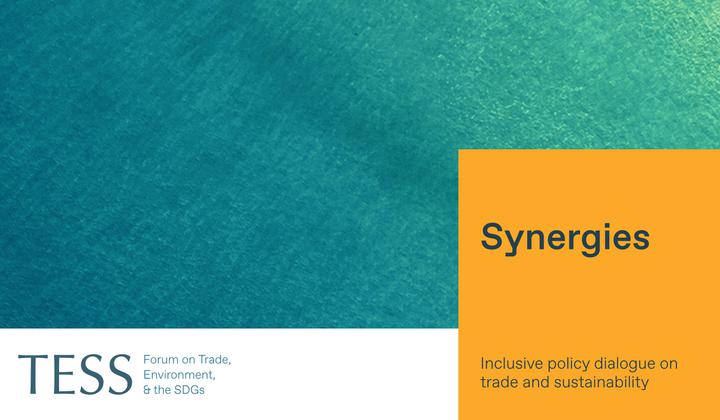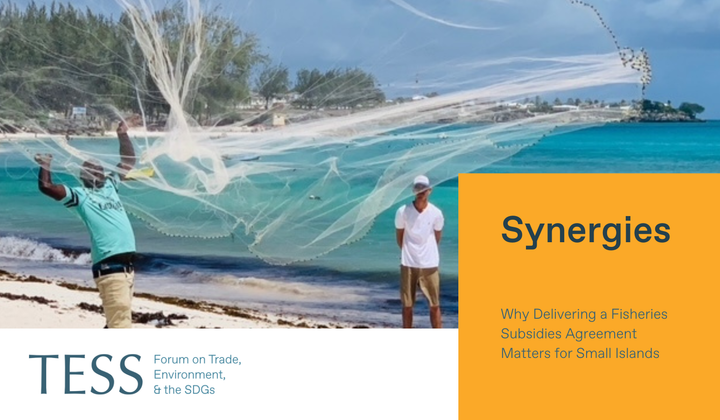In the absence of consensus within the WTO on the ground rules for trade-related climate measures and policies, some members are introducing such measures unilaterally. This has aroused concerns, especially among developing countries, and raises the issue of differentiated treatment in implementing trade-related climate measures and policies. Regarding such treatment, existing WTO provisions and jurisprudence provide pathways for the appropriate design and implementation of trade-related climate measures and policies in a manner consistent with similar commitments in the climate regime.
This article is part of a Synergies series on reviving multilateralism curated by TESS titled From Vision to Action on Trade and Sustainability at the WTO. Any views and opinions expressed are those of the author(s) and do not necessarily reflect those of TESS or any of its partner organizations or funders.
-----
As the World Trade Organization (WTO) approaches its Thirteenth Ministerial Conference (MC13) in late February this year, the issue of trade and environment continues to witness divergent views among its members. While there seems to be broad support for continuing discussions in the Committee on Trade and Environment, there are differences on what the specific discussions should be about and what the role of the WTO should be in addressing the challenge of climate change. In order for the discussions to be constructive and meaningful, it is essential that members have a common understanding of each other’s concerns and expectations.
Climate change is a global crisis and requires global solutions. Given the multidimensional nature of the crisis, the search for solutions cannot be confined to deliberations in one body. In view of the large interface between trade and the environment, the WTO as a multilateral organization clearly has an important role to play in addressing the issue. Equally obviously, the WTO’s role needs to be consistent with, and complementary to, the multilateral environmental agreements as well as the continuing discussions in the specialized bodies such as the United Nations Framework Convention on Climate Change (UNFCCC). This is especially so because trade-related climate measures and policies typically implicate other branches of international law, beyond trade law.
The Issue of Differentiated Treatment
In the absence of any consensus within the WTO regarding the ground rules for trade-related climate measures and policies, some members are introducing such measures unilaterally. An example is the EU’s Carbon Border Adjustment Mechanism (CBAM), which seeks to apply an additional levy on the carbon emissions associated with certain imports into the EU, with the aim of aligning carbon prices of imported goods with those of domestically produced goods. Such measures have aroused widespread concerns, especially among developing countries, that they can lead to fragmentation of trade and severely disadvantage exports of developing countries that may not have the resources or the technologies to limit carbon emissions. There are also apprehensions among developing countries and their businesses that such measures constitute non-tariff barriers being erected to deny them their competitive advantage. An important concern is the extent to which such measures could conflict with the commitments of developing and least developed countries under the multilateral environmental agreements.
Measures like the CBAM bring to centre stage the issue of differentiated treatment for developing and least developed countries in implementing trade-related climate measures and policies.
Indeed, measures like the CBAM bring to centre stage the issue of differentiated treatment for developing and least developed countries in implementing trade-related climate measures and policies. Differentiated treatment, which is based on the requirement of equity, has been heavily negotiated in the multilateral environmental agreements and the principle of common but differentiated responsibilities and respective capabilities (CBDR-RC) is a key element of the tightly negotiated balance of rights and responsibilities of various countries within the climate regime. The principle of CBDR-RC has been described as “a fundamental part of the conceptual apparatus of the climate change regime, such that it forms the basis for the interpretation of existing obligations and the elaboration of future international legal obligations within the climate change regime.” The centrality and relevance of CBDR-RC to the climate change regime was highlighted by the UN General Assembly in March last year when it recalled that the UNFCCC and the Paris Agreement “will be implemented to reflect equity and the principle of [CBDR-RC], in the light of different national circumstances.”
Equity as a general principle of law is also recognized in the Preamble to the Marrakesh Agreement Establishing the World Trade Organization as well as in specific provisions of the WTO agreements. Despite the most-favoured nation provision in Article I of the General Agreement on Tariffs and Trade (GATT), the WTO is no stranger to differentiated treatment. A good example is the 1979 GATT Decision on the “Enabling Clause”, which allows developed countries to provide preferential access to goods from developing and least developed countries to promote their economic development. The several special and differential treatment provisions for developing and least developed countries in the WTO agreements seek to give effect to the equity principle.
A Set of Principles of International Law
It is clear that in order to bridge the sharp differences among WTO members regarding trade-related climate measures and policies, they need to agree, as a first step, that commitments in the climate change regime and the WTO agreements must be interpreted in a coherent and mutually supportive manner. The recent report of an International Legal Expert Group considered how this can be accomplished. It identified a set of principles of international law relevant for the design and implementation of trade-related climate measures and policies. The principles are sovereignty; prevention; cooperation; prohibition of arbitrary and unjustifiable discrimination; sustainable development, equity, and CDBR-RC; and transparency and consultation.
It is clear that in order to bridge the sharp differences among WTO members regarding trade-related climate measures and policies, they need to agree, as a first step, that commitments in the climate change regime and the WTO agreements must be interpreted in a coherent and mutually supportive manner.
Regarding differentiated treatment in accordance with the equity principle, the group found that relevant provisions in the GATT/WTO agreements, and the extensive jurisprudence around them, provide pathways for the appropriate design and implementation of trade-related climate measures and policies in a manner consistent with similar commitments in the climate regime.
An important objective of the report is to ignite an informed international debate on the issue, with the aim of creating a common understanding on how this task can be accomplished. The principles of international law identified by the expert group provide a good basis for such a debate in the WTO.
-----
Ujal Singh Bhatia is Honorary Professor at the National Law University Delhi and Advisor to the Council on Economic Policies. He served on the Appellate Body of the WTO from 2011–20 and was the Chairman from 2017–18.
Professor Bhatia was a member of the International Legal Expert Group on Trade-Related Climate Measures and Policies. the views expressed in this article are his own and do not necessarily reflect those of the group or of its members.
-----
Synergies by TESS is a blog dedicated to promoting inclusive policy dialogue at the intersection of trade, environment, and sustainable development, drawing on perspectives from a range of experts from around the globe. The editor is Fabrice Lehmann.
Disclaimer
Any views and opinions expressed on Synergies are those of the author(s) and do not necessarily reflect those of TESS or any of its partner organizations or funders.
License
All of the content on Synergies is licensed under a Creative Commons Attribution-NonCommercial-ShareAlike 4.0 International (CC BY-NC-SA 4.0)
license. This means you are welcome to adapt, copy, and share it on your platforms with attribution to the source and author(s), but not for commercial purposes. You must also share it under the same CC BY-NC-SA 4.0 license.
If you would like to reuse any material published here or if you have any other question related to Synergies, send an email to fabrice.lehmann@graduateinstitute.ch.




